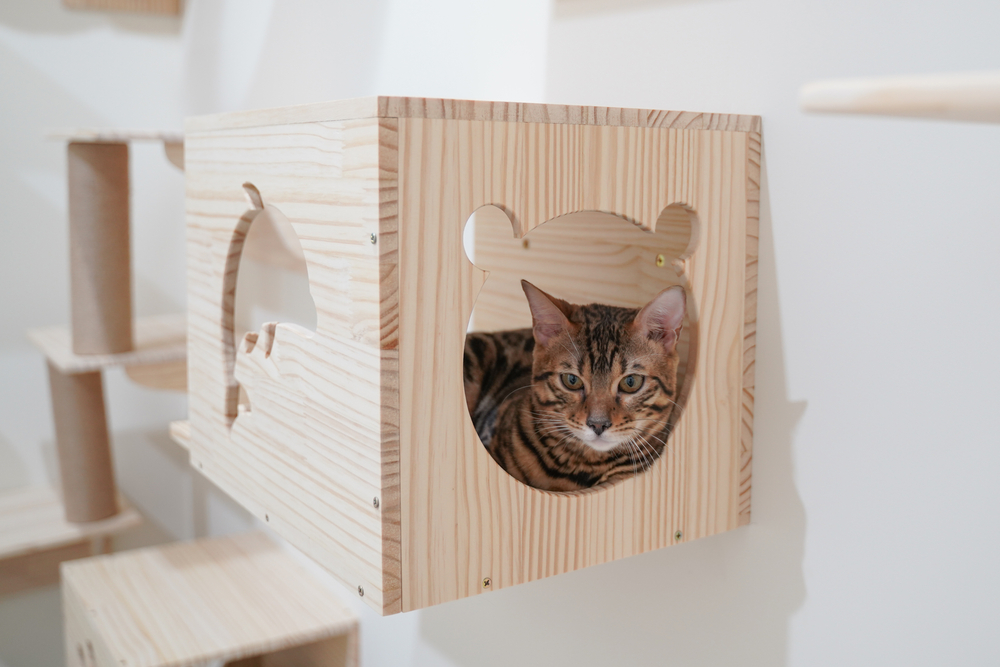Humans have chosen feline companions for more than 10,000 years. In some nations, cats were worshiped and treated like royalty, so it’s no surprise that many cats have embraced being worshiped by their human family. Cats’ independent and sometimes frisky personalities make them special, and they need special care. A feline companion needs more than good nutrition and a clean litter box—they also require mental and physical enrichment to ensure they are physically and mentally healthy, despite spending much of their day sleeping. Many pet owners opt to keep their feline friend indoors, protected from outside dangers, including wildlife, being hit by a car, and exposure to infectious diseases, which is a key part of responsible pet ownership. It’s also important to keep your cat indoors to prevent them from stalking your bird feeder, as cats are a significant threat to wild bird populations. However, it’s vital that your indoor cat express natural and instinctive behaviors they would normally be exposed to in an outdoor environment. Our Liberty Veterinary Hospital team suggests four enrichment activities for your indoor feline friend.
#1: Stimulate your cat’s natural desire to hunt
Cats have a natural instinct to hunt and catch prey, and your cat is unlikely to come across this opportunity indoors, other than the occasional bug. Encouraging your cat’s instinctive behaviors, such as stalking, will improve their overall well-being, in addition to strengthening the bond between you. Cats are also solitary hunters, so place toys or food treats around their environment to stimulate their brain to search for hidden prey. Provide your cat with interactive toys that mimic prey, such as a feather wand or toy mouse. Introduce these enrichment tools when your cat is young, which will discourage them from going after your hands and feet. Additionally, provide a variety of toys, and rotate them to prevent boredom or disinterest. Food puzzles or puzzle balls also provide your cat with opportunities to mimic hunting and eating prey, and will encourage problem-solving skills. Designate daily, consistent play times with your cat, allowing them to occasionally catch the prey so they do not become frustrated.
#2: Provide your cat a safe space to hide
Our feline friends are naturally territorial, and it’s vital that they have designated safe spaces throughout the home where they can retreat and feel protected. You may have noticed your cat resting in a closet space tucked away behind your favorite shoes, or under the bed. Cats are experts at selecting hiding spots, so ensure you always check cabinets, drawers, washers and dryers, and closets before closing any doors. Discourage dangerous hiding spots, and encourage safe cat spaces by placing a blanket or cat bed in areas where your cat gravitates to rest. For less picky cats, the designated space could include:
- Travel crate that remains open for your cat to come and go as they please
- Cardboard box with a blanket
- High-sided cat bed in a quiet corner, or on a safe shelf
#3: Stimulate your cat’s senses
Cats, like people, require regular stimulation of their senses, especially smell, which provides them with important information, including detecting prey, threats, or knowing when they are safe. Your cat will also mark their territory by rubbing their face or scratching areas to place their pheromones on their core environment. If possible, avoid using strong smelling cleaners or detergents in areas where you observe your cat marking, to prevent interference with this natural behavior. You can also stimulate your cat’s other senses by bringing the outside world to their indoor paws, including:
- Placing a bird feeder outside a window where your cat can see the birds the feeder attracts
- Planting flowers that will attract various bugs outside a perchable window
- Playing a special cat video of fish or outdoor environments
- Providing fresh catnip, or treats
- Playing special music that is designed to calm and stimulate cats’ brains
- Spraying natural cat pheromones, such as Feliway
- Bringing non-toxic flowers, leaves, and plants inside for your cat to investigate, after checking the ASPCA toxic plant list to ensure they are safe
#4: Provide your cat with ways to climb and perch

Many cat owners have watched in terror as their daring feline walked across a ceiling shelf, or rested on top of the refrigerator. However, there is no need to get out the ladder, or call the fire department, to retrieve your brave cat. Cats are natural climbers, and they seek out a high location to observe the world below, to relieve stress and feel safe, especially in multiple cat households. Your home may be one level, but your cat still needs a high area, such as:
- Tall cat tree or scratching post with resting platform
- A do-it-yourself shelf with a non-slip surface in a cat-accessible location
- A bookshelf or wardrobe where your cat can rest, with a chair or other furniture nearby so they can safely reach or get down from the resting spot
Cats are skilled at hiding signs of stress or anxiety. If you notice your cat is no longer enjoying their enrichment toys, or they are spending excessive time in their hiding places, bring them for a veterinary exam to rule out any medical or behavior problems. Call our Liberty Veterinary Hospital office if you have any questions about enriching your indoor cat, or to schedule them for a wellness care appointment.








Leave A Comment